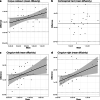The impact of susceptibility correction on diffusion metrics in adolescents
- PMID: 33893847
- PMCID: PMC8266789
- DOI: 10.1007/s00247-021-05000-3
The impact of susceptibility correction on diffusion metrics in adolescents
Abstract
Background: Diffusion tensor imaging is a widely used imaging method of brain white matter, but it is prone to imaging artifacts. The data corrections can affect the measured values.
Objective: To explore the impact of susceptibility correction on diffusion metrics.
Materials and methods: A cohort of 27 healthy adolescents (18 boys, 9 girls, mean age 12.7 years) underwent 3-T MRI, and we collected two diffusion data sets (anterior-posterior). The data were processed both with and without susceptibility artifact correction. We derived fractional anisotropy, mean diffusivity and histogram data of fiber length distribution from both the corrected and uncorrected data, which were collected from the corpus callosum, corticospinal tract and cingulum bilaterally.
Results: Fractional anisotropy and mean diffusivity values significantly differed when comparing the pathways in all measured tracts. The fractional anisotropy values were lower and the mean diffusivity values higher in the susceptibility-corrected data than in the uncorrected data. We found a significant difference in total tract length in the corpus callosum and the corticospinal tract.
Conclusion: This study indicates that susceptibility correction has a significant effect on measured fractional anisotropy, and on mean diffusivity values and tract lengths. To receive reliable and comparable results, the correction should be used systematically.
Keywords: Adolescents; Brain; Diffusion tensor imaging; Magnetic resonance imaging; Susceptibility correction; Tractography.
Conflict of interest statement
No funding was received especially for this study. However, the study was funded with grants supporting the PIPARI study group. The supporting nonprofit foundations were the Arvo and Lea Ylppö Foundation and the Foundation for Pediatric Research. Also, Finnish state funding for university-level health research was received for this study. The Tyks Foundation provided a workstead for writing.
Figures




References
-
- Lebel C, Gee M, Camicioli R, et al. Diffusion tensor imaging of white matter tract evolution over the lifespan. Neuroimage. 2012;60:340–352. - PubMed
-
- Lebel C, Treit S, Beaulieu C. A review of diffusion MRI of typical white matter development from early childhood to young adulthood. NMR Biomed. 2017;32:e3778. - PubMed
-
- Albaugh MD, Ducharme S, Karama S, et al. Anxious/depressed symptoms are related to microstructural maturation of white matter in typically developing youths. Dev Psychopathol. 2017;29:751–758. - PubMed
MeSH terms
LinkOut - more resources
Full Text Sources

